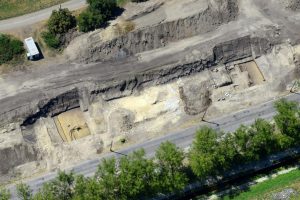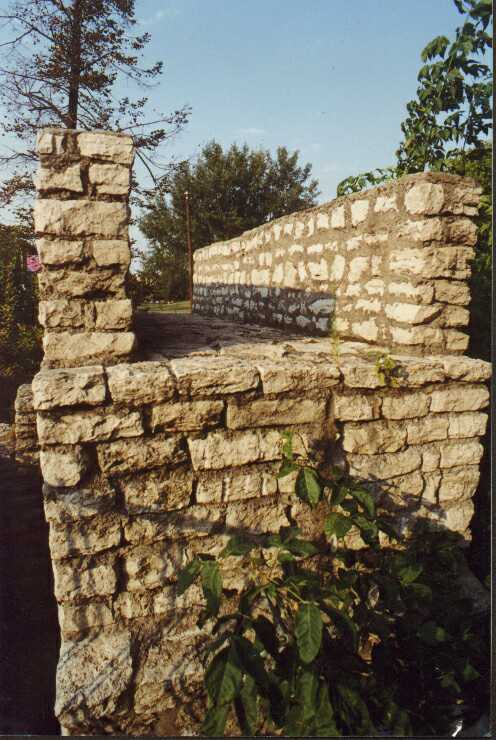The Aquincum traffic jam blog, which brings you Óbuda’s hidden and not-so-hidden Roman remains, is back on the road. Even if there’s not much traffic to speak of these days. Next up: the northern wall of the Aquincum Civil Town!
In Óbuda we can come across Roman remains or modern structures hiding them if we take a quick look every now and again to the right or the left. Last time we visited the Civil Town’s southern cemetery. We now continue our journey on the other side of the ancient settlement with the northern town wall.
So where are we now?
We are heading north on the Szentendrei Road. We go past the Aquincum Museum and Archaeological Park, then, some 100 metres after the railway bridge we see on the right a reconstructed section of the Civil Town’s northern wall.
But first the history!
The civilian settlement of Aquincum under the reign of the Emperor Hadrian – who, earlier on in his career served as the first governor of Lower Pannonia – in the 120s CE received city status with the rank of municipium.
The town was surrounded by walls, between 1.1 and 1.7 metres thick. In the walls were gates in the four cardinal directions. On the inside ran an embankment to help the movement of defenders, while on the outside a road and a ditch followed the path of the wall.
During the Roman period the walls saw several changes. Of these the most significant were the reinforcement of the western half of the town, and the removal of the eastern wall. Towards the end of the 2nd century, the area protected in the west was extended and a new wall with corner towers and wall towers projecting inward was constructed.
For over a hundred years the eastern town wall had been a mystery for archaeologists. The defences – or their traces – had been found on the other three sides, but the eastern section refused to appear. All this changed in 2013. On the Budapest-Esztergom line, a bridge of the railway embankment was to be remodelled, and an excavation at the site for one of the new abutments uncovered the traces of the removed eastern town wall.

The site of the excavation
The eastern wall had, in fact, been dismantled during the first half of the 3rd century by the Romans. This period saw the heyday of Aquincum, and the growing town needed the space. There was peace on the imperial border at this time, so the defences facing the Danube could be removed.
Roman towns were not only surrounded by walls in a physical sense. According to ancient Roman custom – which, like so much else, they copied from the Etruscans – at the foundation of new cities, a furrow was ploughed around the designated area with a bull and a cow. This first furrow marked the sacred boundary of the town, the so-called pomerium. So that no one would violate it (according to the legend, Remus had to die because he had jumped across the rudimentary walls of Rome), at the site of the future gates the plough was lifted, providing access to and from the town. Within the area marked by the plough, certain activities and establishments were forbidden. As we have seen the last time, for instance cemeteries were strictly located beyond the town (and its pomerium).
The religious boundary marked by the plough was a characteristic of Roman towns. Aquincum, however, began its urban career as a municipium, i.e. a local community accepted by Rome as a town, as opposed to a city established by the Romans themselves, like the so-called coloniae. Did, then, Aquincum get a pomerium when – together with the Military Town – it received the rank of colonia in 194 CE? Where could this sacred boundary have been located? These questions, however, cannot be answered for now.

The reconstructed section of the aqueduct crossing the town wall
What can we see today?
The defences were partly removed in antiquity (eastern wall), and partly filled in (e.g. sections of the southern ditch). As for the other sections, later periods came to use their excellent building materials for new constructions. Archaeologists could often only find the bottom course of the foundations and the traces of the ‘quarries’.
A 25-metre-long section of the 2nd-3rd-century northern town wall, however, was reconstructed. Next to the Szentendrei Road in a small enclosure we can see the wall with its battlements, the ditch, and the section of the aqueduct where it crossed into the town.
Soon we’ll continue our search for Roman remains as there are still plenty of other hidden and conspicuous monuments to discover in Óbuda; but more on those later.
Until then, take care!
Zoltán Quittner
1 April 2020
Click here to read the previous entries of the Aquincum traffic jam blog!


